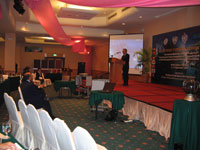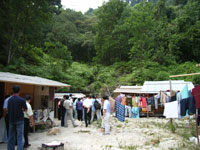1. Introduction
From September 5 through September 8, 2005, a workshop of the Hydrology Component of the Typhoon Committee was held in Kuala Lumpur, Malaysia.
2. Activities against sediment-related disasters
The Typhoon Committee practices activities in three components: the Meteorology Component, Hydrology Component, and Disaster Prevention and Preparedness Component. A workshop of the Hydrology Component was held in September. (See Photo 1.)
The Hydrology Component carries out various projects, such as flood hazard maps, flood forecasting, and sediment-related disaster forecasting and warning. With regard to the Sabo related projects, Japan serves as a presiding country of a project related to sediment-related disaster forecasting and warning technologies and carries on with this project with an aim to establish a forecasting and warning system for sediment-related disasters in each country.
So far in this project, we presented the technology to establish the warning and evacuation criteria for sediment-related disasters, which is part of the sediment-related disaster forecasting and warning technologies, to the member countries. Based on this technology, each member country will establish the warning and evacuation criteria and test it in pilot test areas to find out problems, etc.
This project will be completed in 2007, and after the completion of the project, each country will apply the warning and evacuation criteria to other areas in addition to the pilot test areas and establish a forecasting and warning system for sediment-related disasters.
In the workshop held in September, activities at pilot test areas were reported from Malaysia and China. In the meantime, some countries struggle to carry out the project because of difficulty in installing a rain gauge and other devices, organizing an information system, and coping with administrative and maintenance expense. How we should carry on with the project in these countries is an issue to be solved.
3. On-site session for designation of debris flow hazard areas
In the workshop, in addition to progress reports on the forecasting and warning system in each country, an on-site session for designation of hazard areas subject to sediment-related disasters was held, as considering this technology is closely related to the sediment-related disaster forecasting and warning technologies. (See Photo 2.) The contents in the document for the technology to designate hazard areas, which was distributed during the previous meeting, were explained again, and this technology was actually applied during the on-site session.
The on-site session was held in the suburb of Kuala Lumpur to designate debris flow hazard areas. An example case of designation of hazard areas in this region had been created in advance, and a discussion was made how to designate the hazard areas as actually seeing the start point of a debris flow and the direction and extent of the flow, etc. in the site. The on-site session was fruitful with active discussions although there was a problem that the geography of the site had been changed. The fact that the hazard areas subject to sediment-related disasters have been developed as residential areas reminded us of the importance of designation and notification of such hazard areas.
5. Future course of action
It was suggested that we should expand the project related to sediment-related disaster forecasting and warning and further address the technology to designate hazard areas. In addition, regarding the technique to establish the rainfall warning criteria, it seems that the framework will remain unchanged, and Japan will keep giving advice and support for it.

Conference

On-site discussion

